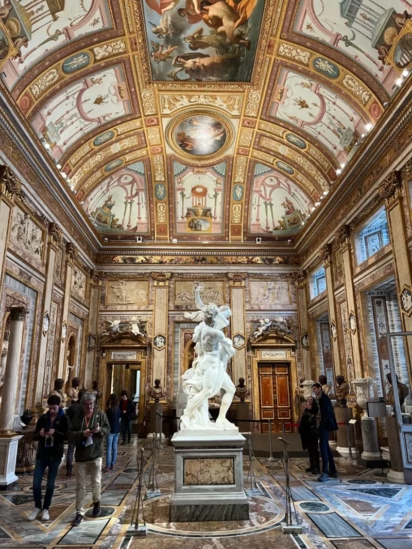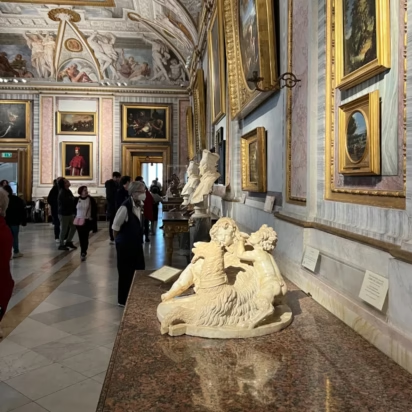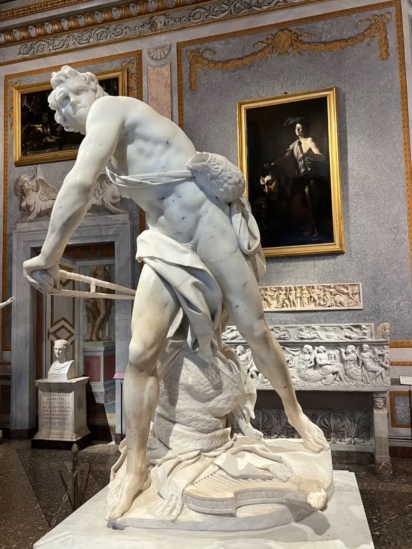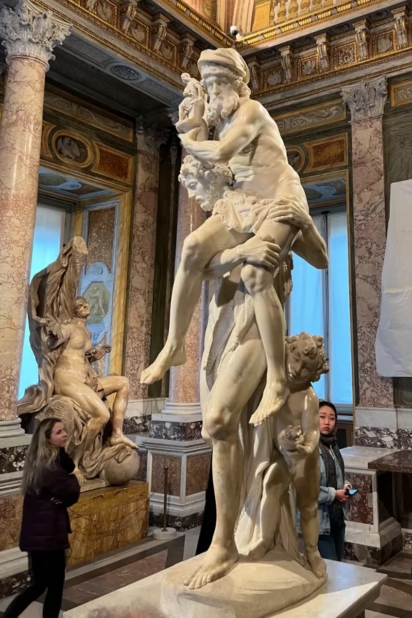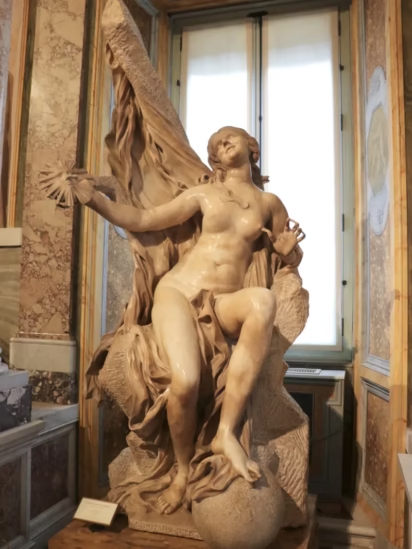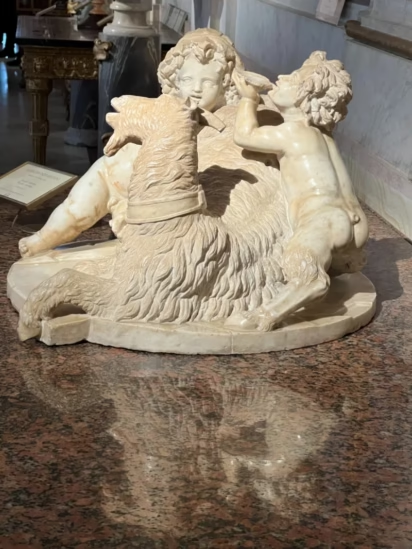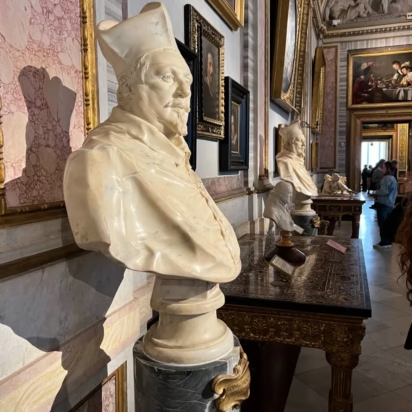The Borghese Gallery in Rome has some of the finest Bernini sculptures in the world including three of the most influential works of the Baroque period: The Abduction of Proserpina, David, and the magnificent Apollo and Daphne.

The Borghese Gallery (Museo e Galeria Borghese) in the Villa Borghese Park is one of the best art galleries to visit in Rome. The four marble sculptures Cardinal Scipione Borghese commissioned for a young Lorenzo Bernini are among the art highlights of this museum and were highly influential in establishing the Baroque period. The Borghese Gallery also has further sculptures by Bernini, including his earliest work and several busts, as well as three very rare Bernini oil on canvas paintings. Buy tickets well in advance — time-slot reservations are essential to see the art in this exceptional gallery.
Top Bernini Sculptures in the Borghese Gallery in Rome
Some of the best Gian Lorenzo Bernini (1598-1680) sculptures in the world are in the collection of the Borghese Gallery in Rome. Most are of a secular nature referring to Greek and Roman mythology but with a Christian moral lesson that made them acceptable for a cardinal’s collection. In the early 17th century, Rome was in the grip of the Counter-Reformation and although a lot of flesh and lust were still acceptable, the full frontal nudity of the Florentine Renaissance was on hold.
Four works commissioned by Cardinal Scipione Borghese established Bernini’s reputation well before he reshaped St Peter’s Basilica and much of Rome into its baroque appearance. These four sculptures are still among the highlights in the Borghese Gallery:
- Aeneas, Anchises, and Ascanius (1619)
- The Rape of Proserpina or The Abduction of Proserpina (1621–22)
- Apollo and Daphne (1622–1625), and
- David (1623–24).
Further Bernini sculptures in the Borghese Gallery are:
- The Goat Amalthea with the Infant Jupiter and a Faun (c. 1609–1615),
- Bust of Pope Paul V (1618),
- Two Busts of Cardinal Scipione Borghese (1632), and
- Truth Unveiled by Time (1645–1652).
The Borghese Gallery also has three rare oil on canvas paintings by Bernini:
- Self-Portrait as a Young Man (c. 1623),
- Self-Portrait as a Mature Man (1635–40), and
- Portrait of a Boy (c. 1638).
All these Bernini works and a terracotta model for a large equestrian statue of Louis XIV (1669-70) are usually on permanent display in the Borghese Gallery in Rome.
One of the most praised Bernini sculptures in Rome — The Ecstasy of Saint Teresa — may be seen for free in the Saint Teresa in Santa Maria della Vittoria Church near Termini Station.
See also Top Art Highlights in the Borghese Gallery for works by further artists on display the villa.
Bernini’s Apollo and Daphne in the Borghese Gallery



Apollo and Daphne (1622–1625) was the last special sculpture Bernini completed for Cardinal Borghese’s private collection. It is among the finest Bernini and Baroque marble sculptures ever made.
The 243 cm (96 in) high marble sculpture group depicts the climax of Ovid’s Metamorphoses: Apollo, fated by Cupid’s love-exciting arrow made of pure gold, had chased and finally caught the nymph Daphne. However, Daphne, fated by Cupid’s love-repelling arrow made of lead, begs for help from her father — the river god Peneus. Rather than fighting Apollo off, Daphne is being transformed into a laurel tree. Her fingers are sprouting leaves. Her feet are turning into roots. Apollo grabs her flesh but gets only a handful of bark, which is also used to ensure the otherwise naked Daphne the right amount of modesty required by the period.
The detailing of the leaves, the lightness of Daphne’s hair, and the bellowing cape of Apollo are incredibly delicate for a marble statue. Similarly, few sculptors would attempt the free-hanging and unsupported left leg of Apollo.
The sculpture is best appreciated from the front right where Apollo’s lust and Daphne’s horror may be seen simultaneously. From certain angles from the rear, only Apollo is seen — it appears as if Daphne is already just a tree. Also when viewed from behind, Apollo’s cape sometimes seems to form an odd roll but only a slight step to the side reveals the material fantastically flying in the wind quite at odds with the natural stiffness of white marble.
Bernini’s The Abduction of Proserpina



Bernini’s The Abduction of Proserpina (Rapimento di Proserpina) is usually translated in English as The Rape of Proserpina (1621–22) but as with similar translations, the English name predicts more what is likely going to happen later than the actual action being portrayed.
In this 225 cm (89 in) high Carrara marble sculpture, Bernini shows a lusty Pluto, the god of the underworld, capturing Proserpina and carrying her off to the underworld. The triple-headed Cerberus symbolizes not only the division between the underworld and earth but here also serves as a support to keep the statue from collapsing. (Bernini was much more daring later with the leg of Apollo.)
In this myth, retold by among others Ovid in his Metamorphoses, Pluto fell in love with Proserpina, the daughter of Jupiter and Ceres, and carried her off to his realm in the underworld. Just in time, Ceres, the goddess of agriculture, heard her daughter’s cry and in anger dried the earth and harvests failed. Jupiter came to an arrangement with his brother Pluto: Proserpina will stay with Pluto in the underworld for half of the year and with Ceres the other half. The seasons are explained and everybody is happy. (Greek / Roman mythology operated on a different level to monotheism and modern societal norms.)
The detail in the sculpture is incredible and particularly famous for the tears in Proserpina’s face and the indentures of the flesh where Pluto holds her. Both figures are nude but for a flowing piece of cloth — its folds on their own a remarkable work of art.
Bernini’s David Sculpture in the Borghese Gallery in Rome
The life-sized, 170 cm (67 in) high marble David (1623–24) is the only Bernini sculpture in the Borghese Gallery with a Christian theme. In contrast to the static Davids of the Renaissance, Bernini showed David in action. The stone is already in the sling and David is ready to swing and attack Goliath.
David is naked but for a piece of cloth that is less elaborated here than in the previous works. More detailed is the armor of King Saul at his feet and the harp.
Bernini modeled David’s face on his own, as can be seen when comparing the sculpture to his Self-Portrait as a Young Man that hangs in a gallery on the museum’s upper floor.
Behind the sculpture is a large David with the Head of Goliath painted by Caracciolo Giovanni Battista called Battistello. The more famous similar painting by Caravaggio is in Room VIII.
Bernini’s Aeneas, Anchises, and Ascanius
Bernini’s first work for Cardinal Borghese was the group Aeneas, Anchises, and Ascanius (1619). Aeneas, a Trojan hero and son of Aphrodite (Venus) was a minor figure in Home’s Iliad but in Roman mythology, including Virgil’s Aeneid, he is of major importance and considered to have moved to Italy as an ancestor of Romulus and Remus (and ultimately the Borgheses).
The 220 cm (87 in) tall marble sculpture shows Aeneas carrying his father Anchises from Troy after it was sacked by the Greeks. Anchises brought along the family’s household deities. Ascanius, the young son, supports his father’s leg to hold the statue up. All are naked but the older two are partly covered by a lionskin — a symbol of power, often associated with Hercules.
This group is the most static of the four special Bernini sculptures in the gallery. However, it is worth keeping in mind that Cardinal Scipione Borghese took a gamble on a 20-year-old sculpture when commissioning this work.
Other Bernini Sculptures and Paintings in the Borghese Gallery
Bernini never completely finished Truth Unveiled by Time (1645–1652). This huge 277 cm (109 in) marble sculpture features Truth, allegorically as a naked young woman, already unveiled but for some cloth covering the groin. She holds a sun in her right hand.
A winged figure or Father Time was supposed to have pulled the clothes away but it was never completed.
The Goat Amalthea with the Infant Jupiter and a Faun (c. 1609–1615) is often considered Bernini’s first solo work. It shows Amalthea (the foster mother of Jupiter / Zeus) as a goat with a young faun helping an infant Jupiter to drink milk. It is quite a remarkable work and composition for a teenager (although some question whether it is by Bernini at all).
The Busts of Scipione Borghese (1632) are mostly famous for there being two. While finishing the first bust, a crack in the marble appeared straight across the forehead of the cardinal’s sculpture. Depending on who is telling the story, Bernini produced a second bust within three days (or up to 12 days) — any of which is still impressive. The two busts are displayed together and the cracked one is perhaps just a little more skilful and vivid.

Between the two busts hang the three Bernini oil on canvas paintings — very few of his paintings survived. Two are self-portraits while the third is a portrait of an unidentified boy. The self-portrait of a 25-year-old Bernini reminds of the David sculpture while the older Bernini is clearly more mature, more serious, and with an intense gaze.
Visit the Borghese Gallery in Rome
The Borghese Gallery in the Villa Borghese Park is one of the finest art museums to visit in Rome. Opening hours are Tuesday to Sunday from 9:00 to 19:00 with admission hourly. (The previous maximum stay of only two hours is not currently enforced.) Time-slot reservation tickets are essential and best booked well in advance.
See also:
- Visit the Villa Borghese Gallery in Rome: Buy the Cheapest Tickets and Tours for details and how to secure the best deals.
- Top Art Highlights in the Borghese Gallery — including six Caravaggio paintings
- See Top Bernini Sculptures in the Borghese Gallery — sculpture masterpieces and three rare paintings.
- More photos of the Borghese Gallery on Flickr.
- Buy the cheapest tickets at TicketOne or check Tiqets and Get Your Guide for more availability and tours.
